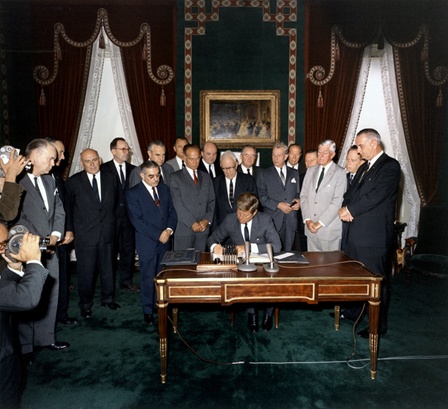Today marks the 50th anniversary of the entry into force of the Partial Test Ban Treaty (PTBT, also known as the Limited Test Ban Treaty or LTBT), on October 10th, 1963. The treaty was the first arms control agreement of the nuclear age, outlawing the explosive testing of nuclear weapons in the atmosphere, in space, and underwater. Despite early plans to call for a ban on all explosive nuclear weapons testing, in the end the treaty did not cover underground explosions, and as a result hundreds of such tests were conducted over the following decades.
Yesterday a shaft of light cut into the darkness. Negotiations were concluded in Moscow on a treaty to ban all nuclear tests in the atmosphere, in outer space, and under water . . . it is an important first step — a step toward peace — a step towards reason — a step away from war.” – President John F. Kennedy, July 26, 1963
Origins of the Treaty
Originally negotiated and signed by the United States, the Soviet Union, and Britain, the treaty arose out of concerns about the negative effects of nuclear testing, and the resulting radioactive fallout, on health and the environment, as well as a desire to try to limit the arms race. At the time, a total ban on explosive nuclear testing while the few states with nuclear weapons programs were still in the early stages of mastering the technology could have prevented further development of some of the most dangerous weapons of the cold war, such as the hydrogen bomb and miniaturized warheads small enough several to fit on one ballistic missile.
While the idea of a ban was first put forth in 1954, it was only the 1962 Cuban Missile Crisis and the accompanying realization among leaders and the public of how close the world had come to the brink, that finally added a sense of urgency to the enterprise. That crisis helped push U.S. and Soviet negotiators to break through previous deadlocks. The drafting of the PTBT was one of the shortest negotiations in arms control history, and the U.S. Senate ratified it less than two months after it was signed by a vote of 80 to 19.
One of the first problems raised in trying to achieve a PTBT was how to verify that the parties were not violating it. In order to get agreement, the signatories had to work out a system of monitoring and inspections to ensure that none of the states could clandestinely test a nuclear weapon. Part of the reason the original treaty did not include a ban on underground tests was that experts were not sure that the monitoring technologies at that time were sufficient to detect cheating if a state tested underground.
Contrast between the PTBT and CTBT
The contrast with the current controversy over a Comprehensive Test Ban Treaty (CTBT) is instructive. Although the United States signed the CTBT in 1996, when the treaty came up for ratification in 1999 the Senate rejected it, with only 48 of the required 67 votes in favor. Some who opposed the treaty simply did not believe that placing such limits on the United States would ever be a good idea. But, as with the PTBT, others questioned whether cheaters could be detected. In addition, some cited uncertainty about whether tests would be needed to ensure that the aging U.S. nuclear stockpile remained safe, secure, and reliable.
Fortunately, the technical questions have been addressed in the intervening years. Monitoring technologies have improved immensely since the time of the PTBT and, since the first U.S. attempt to ratify the CTBT in 1999, major international networks of sensors have been built up to supplement national capabilities. At the same time, the success of the Stockpile Stewardship Program has increased confidence that the United States can maintain its nuclear stockpile as long as it is needed without resorting to nuclear explosive testing. According to a 2012 National Academy of Sciences report on technical issues that might affect the U.S. decision to ratify the CTBT,
The most serious requirement for sustaining the U.S. stockpile and monitoring capabilities is a clear statement of policy regarding the capabilities that must be maintained, combined with management and support focused on achieving well-defined technical goals underpinning those capabilities…The need for such action arises whether or not the United States ratifies the CTBT.
That is, policy, not technology, is the limiting factor this time.
The Future of the CTBT
While the Obama administration said in 2009 that it will once again work toward ratification of the CTBT, it has not indicated when it plans to pursue a new vote in the Senate in support of the treaty. And with domestic and international political crises aplenty facing the president, it is not clear when a new attempt might be possible.
Recent developments abroad, however, provide some new hope for progress. For the CTBT to enter into force, all 44 states with some nuclear capability must ratify the treaty. Eight, including the United States, have been holdouts, making that seem an unlikely accomplishment. China has declared its support for entry into force of the treaty, and is likely to ratify it once the United States does. The new government in Iran, another of the eight, has recently moved to begin negotiations on its nuclear program, raising hopes that these may lead to ratification. The road ahead is still long, with some key states remaining outside the treaty’s framework, but may not be the dead end that some had feared. Ratification by the United States could encourage further movement, as well as provide greater leverage to pressure any remaining holdouts.
Even from a purely practical point of view, the United States has a strong argument for pushing ahead. The United States has not conducted a nuclear test since 1992. Today, it is obeying the terms of the CTBT (not testing), but not getting the benefits of the treaty’s verification and inspection regime to ensure that others are also playing by the rules.
When President Kennedy signed the PTBT 50 years ago, he told the American people that it was “an important first step—a step toward peace—a step towards reason…” The next step was obvious more than 50 years ago. It is well past time to take it.

